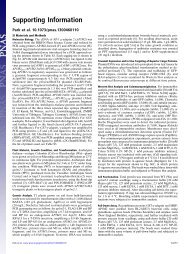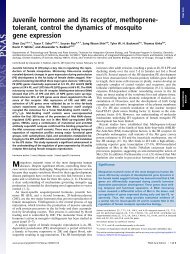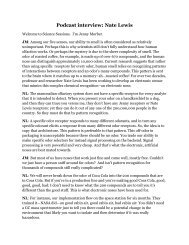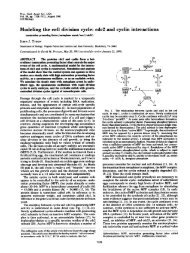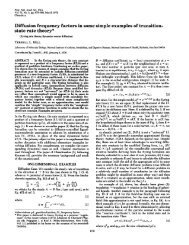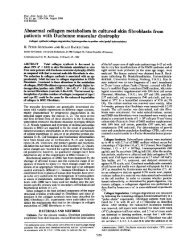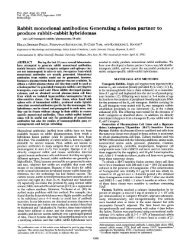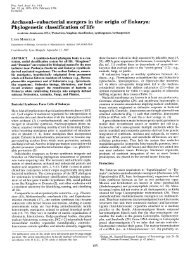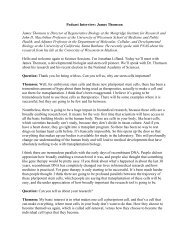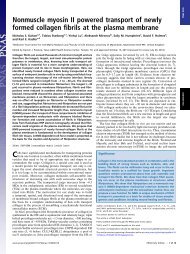SUMO-1 - Proceedings of the National Academy of Sciences
SUMO-1 - Proceedings of the National Academy of Sciences
SUMO-1 - Proceedings of the National Academy of Sciences
You also want an ePaper? Increase the reach of your titles
YUMPU automatically turns print PDFs into web optimized ePapers that Google loves.
Table 1. Potential acceptor sites for <strong>SUMO</strong>-1 in selected nuclear<br />
receptors<br />
Receptor Residue Domain Sequence Swiss-Prot no.<br />
hAR K386 NT PHARIKLENPLDY P10275<br />
K520 NT SPTCVKSEMGPWD<br />
hGR K277 NT TLPQVKTEKEDFI P04150<br />
K293 NT TPGVIKQEKLGTV<br />
K703 LBD GKAIVKREGNSSQ<br />
hMR K89 NT LTSDIKTELESKE P08235<br />
K399 NT IVQYIKPEPDGAF<br />
K427 NT FSVPIKQESTKHS<br />
K494 NT FPVGIKQEPDDGS<br />
K953 LBD ESHALKVEFPAML<br />
hPR K388 NT PALKIKEEEEGAE P06401<br />
hER� P03372<br />
hER� Q92731<br />
hTR� K283 LBD GEMAVKREQLKNG P21205<br />
NT, amino-terminal region; LBD, ligand-binding domain.<br />
which was more intense than that observed with K386R (Fig. 3A,<br />
lane 4). Importantly, no sumoylated forms <strong>of</strong> AR were detected<br />
with <strong>the</strong> double mutant. Toge<strong>the</strong>r, <strong>the</strong>se results confirm that AR<br />
is modified by <strong>SUMO</strong>-1 on <strong>the</strong> amino acids K386 and K520, with<br />
<strong>the</strong> former one being <strong>the</strong> principal acceptor site.<br />
To examine whe<strong>the</strong>r some o<strong>the</strong>r nuclear receptors could serve<br />
as substrates for Ubc9, we looked for putative sumoylation sites<br />
in <strong>the</strong> sequences <strong>of</strong> steroid receptors and thyroid hormone<br />
receptor � (TR�). N-terminal regions <strong>of</strong> AR, GR, mineralocorticoid,<br />
and progesterone receptors and ligand-binding domains<br />
<strong>of</strong> GR, mineralocorticoid receptor, and TR� contain putative<br />
<strong>SUMO</strong>-1 attachment sites, whereas estrogen receptors � (ER�)<br />
and � (ER�) do not possess sequences matching with <strong>the</strong><br />
consensus sequence (Table 1). After incubation <strong>of</strong> in vitrotranslated<br />
GR, ER�, ER�, and TR� under <strong>the</strong> same conditions<br />
as those for AR, a slowly migrating form <strong>of</strong> GR appeared in <strong>the</strong><br />
presence but not in <strong>the</strong> absence <strong>of</strong> Ubc9 (Fig. 3B Left). In<br />
contrast, no Ubc9-dependent derivatives <strong>of</strong> ER�, ER�, orTR�<br />
were detected (Fig. 3B Right), suggesting that <strong>the</strong> latter receptors<br />
are not sumoylated. The high-molecular weight bands seen with<br />
ER� and ER� are not likely to represent <strong>SUMO</strong>-1 conjugates,<br />
because <strong>the</strong>ir appearance did not depend on Ubc9 that is <strong>the</strong> only<br />
<strong>SUMO</strong>-1-conjugating enzyme known thus far.<br />
Disruption <strong>of</strong> <strong>the</strong> <strong>SUMO</strong>-1 Acceptor Sites Enhances Transcriptional<br />
Activity <strong>of</strong> AR. Transactivation assays using minimal<br />
ARE2TATA-LUC reporter containing two hormone response<br />
Fig. 4. Substitutions <strong>of</strong> <strong>the</strong> sumoylation sites activate AR. (A) Transactivation by 10 ng <strong>of</strong> wt Flag-AR and <strong>the</strong> mutants K386R, K520R, and K386R�K520R was<br />
studied on minimal pARE2-TATA-LUC reporter (150 ng) in COS-1 cells. The cells received 100 nM testosterone (�T) or vehicle (�T) 18 h after transfection. LUC<br />
activities in cell extracts were adjusted to <strong>the</strong> transfection efficiency by using �-galactosidase activity. The activity <strong>of</strong> AR in <strong>the</strong> presence <strong>of</strong> testosterone is set<br />
as 100, and <strong>the</strong> means � SD from at least six independent experiments are shown. (B)AsinA, except that cells were transfected with 1–100 ng <strong>of</strong> AR expression<br />
plasmids as indicated. The amount <strong>of</strong> transfected DNA was balanced by <strong>the</strong> addition <strong>of</strong> empty expression vector. (Inset) Expression levels <strong>of</strong> wt AR and<br />
K386R�K520R mutant in an experiment corresponding to data shown in B. AR was immunoblotted with AR antibody from <strong>the</strong> same lysates (pooled from triplicate<br />
wells) that were used for reporter gene assays. (C) Effect <strong>of</strong> coexpressed Ubc9 on transactivation by AR and K386R�K520R. The conditions were as in A, except<br />
that indicated amounts <strong>of</strong> pFLAG-Ubc9 (in �g) were cotransfected and <strong>the</strong> total amount <strong>of</strong> DNA was balanced by adding empty pFLAG-CMV2. Black bars depict<br />
wt AR and gray ones K386R�K520R mutant.<br />
14148 � www.pnas.org Poukka et al.



